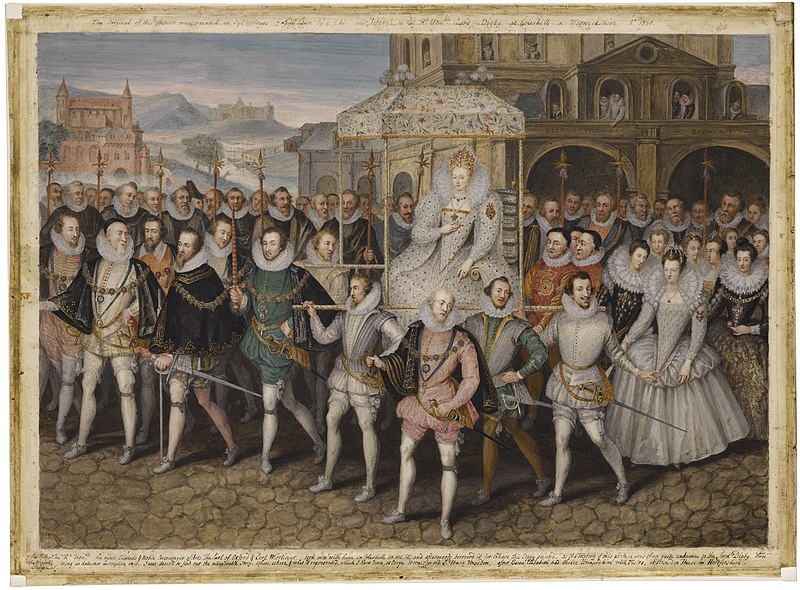Introduction of My Selected Ruler
In this blog post, a ruler from England during 1485-1688 that I would like to introduce is Elizabeth I. The JSTOR article I have selected to accompany my blog post is the "The Procession Portrait of Queen Elizabeth I: A Note on a Tradition" by David Armitage, and continuing with my theme in this semester, what is the place of artists and the art they create? Elizabeth I was the last ruler of the Tudor Dynasty of the Early Modern England Period. Her rulership had greatly influenced the future of England, in the 69 years she lived and 44 years on the throne, she had secured a bright path to England's world-wide domination, one of which is the defeat of Spanish Armada. Her rulership sometimes was in fact questioned, troubled by domestic problems, but throughout the 44 years, she had provided stableness for England, which earned her a incredible reputation. Personally, she was a known catious ruler, one of her mottos was in Latin, "video et taceo" which translates to "I see and keep silent."
During her Elizabethan era, many had celebrated her greatness in portraits, so there are a lot of them out there. One of the most interesting portrait that stands out the most in my opinion is not any other singly focused portraits, but rather a portrait in procession, "The portrait is almost unique among representations of Elizabeth in being both horizontally disposed and narrtive rather than emblematic; the only example that sharing these features comes from early in the reign, in Marcus Gheeraerts's engraving of the Garter Procession of 1576."(Procession 5) In addition, here is a video that shows some of the items that represent Elizabeth I's power that are other than her classic emblematic portraits.
Portraits and propaganda of Queen Elizabeth I of England | Curator's Corner S2 Ep 8 - Youtube - By The British Museum
Portrait of My Selected Ruler
 |
| Elizabeth I, Procession Portrait, by George Vertue circa 1600, Sherborne Castle, Dorset |
The portrait I will be discussing, as I have expressed earlier, is the Procession Portrait of Elizabeth I. The aritist who painted this portrait is George Vertue, presumably painted in 1600. The location that this painting is housed today is in the Sherborne Castle, in Dorset, England. This portrait is rather intriguing in my opinion, because this is unlike other portraits that usually focuses on Elizabeth I alone emblematically, or to celebrate her title as the Virgin Queen.
There is one mystery that surrounds this portrait, "It remains one of the greatest visual mysteries of the Elizabethan age."(Procession 1) Is actually the portrait's historical accuracy, due to the reason that it is suspected the potrait does not match with the historical description, "Finally, we are told that at the Blackfriars of 1600, 'The bride met the Queen at the water side, where my Lord Cobham had provided a lectica, made like a litter, whereon she was carried to my Lady Russell's by six knights.' None of these descriptions corresponds to the portrait, in which Elizabeth sits in a chair of state covered by a canopy held by four courtiers."(Procession 5-6) This is rather strange because we can clearly see in this painting that Queen Elizabeth I was carried by four courtiers in the front and was covered with a canopy.
Why I Selected This Ruler and Portrait
Though this portrait remains strange, but not all things unsure of. After all, Elizabeth did had a record like this "For example, on Sunday 15 January 1559, Elizabeth was drwan from Whitehall to her coronation at Westminster in a horse-litter with a canopy carried above her by four men."(Procession 5)
The reason that I'm interested in this ruler, Elizabeth I, is because how many of her achievements had formed an aura, which now that she can been as the pride of England, for being one of the most important rulers in England's history. A portrait like this one exactly connected the idea that Elizabeth I is a ruler that England needed. For its connection to my theme in this semester, knowing the place of the artist and the arts they create can be very important because it helps us identify what they represent, and this portrait seems to affirm my theme because its very origin is still questionable, which further reminds us of understanding the origin of the art is indeed important, not only it is the information we need, but also the connection to the artist and the overall history.
Works Cited
Armitage, David. “The Procession Portrait of Queen Elizabeth I: A Note on a Tradition.” Journal of the Warburg and Courtauld Institutes, vol. 53, 1990, pp. 301–307. JSTOR, www.jstor.org/stable/751357. Accessed 9 May 2021.
“Portraits and Propaganda of Queen Elizabeth I of England | Curator’s Corner S2 Ep 8 #CuratorsCorner.” Www.youtube.com, www.youtube.com/watch?v=xqWTiYBkhKA. Accessed 9 May 2021.
"File:Elizabeth I, Procession Portrait..jpg." Wikimedia Commons, the free media repository. 20 Jan 2021, <https://commons.wikimedia.org/w/index.php?title=File:Elizabeth_I,_Procession_Portrait..jpg&oldid=527208838>. Accessed 9 May 2021.
Comments
Post a Comment